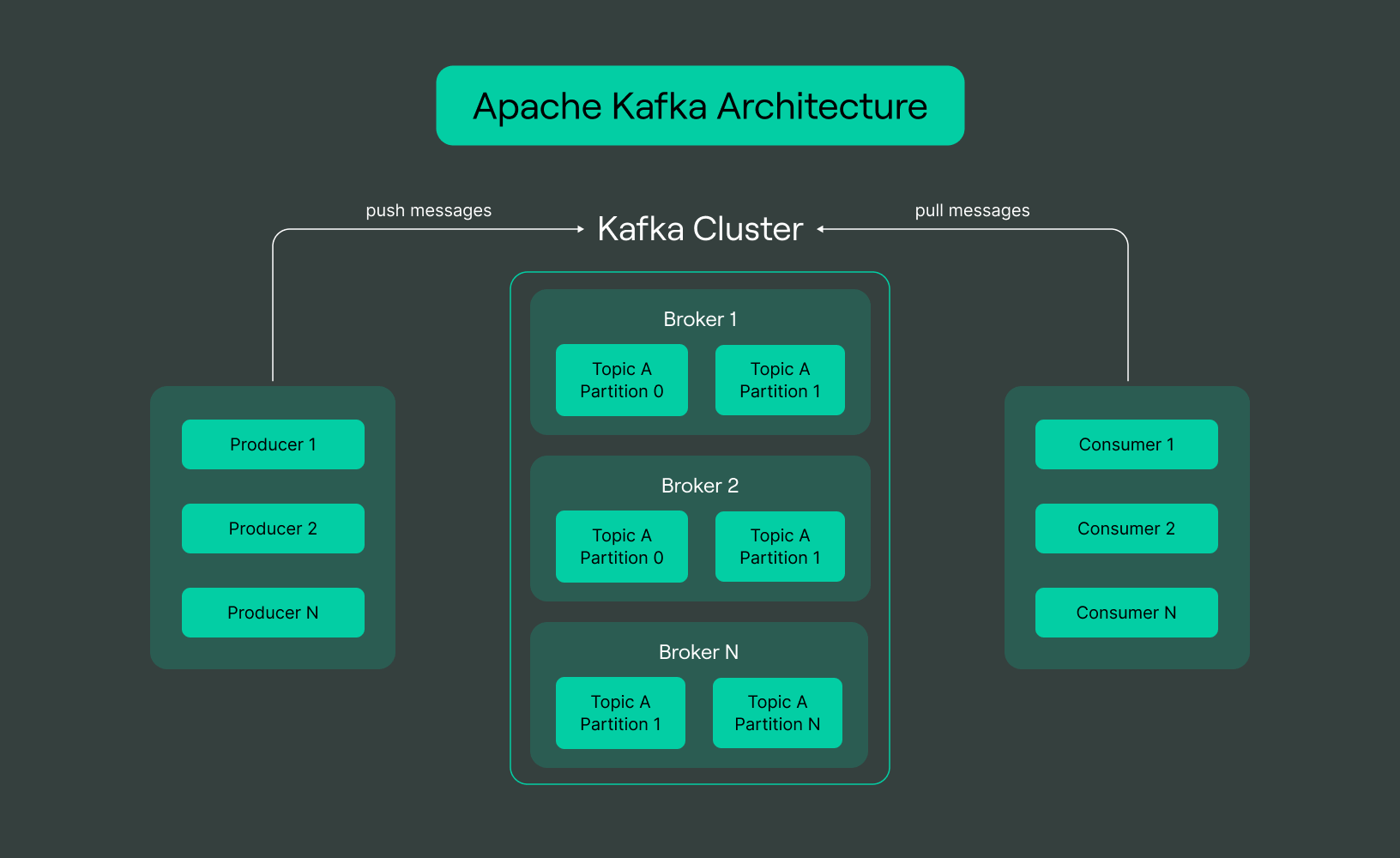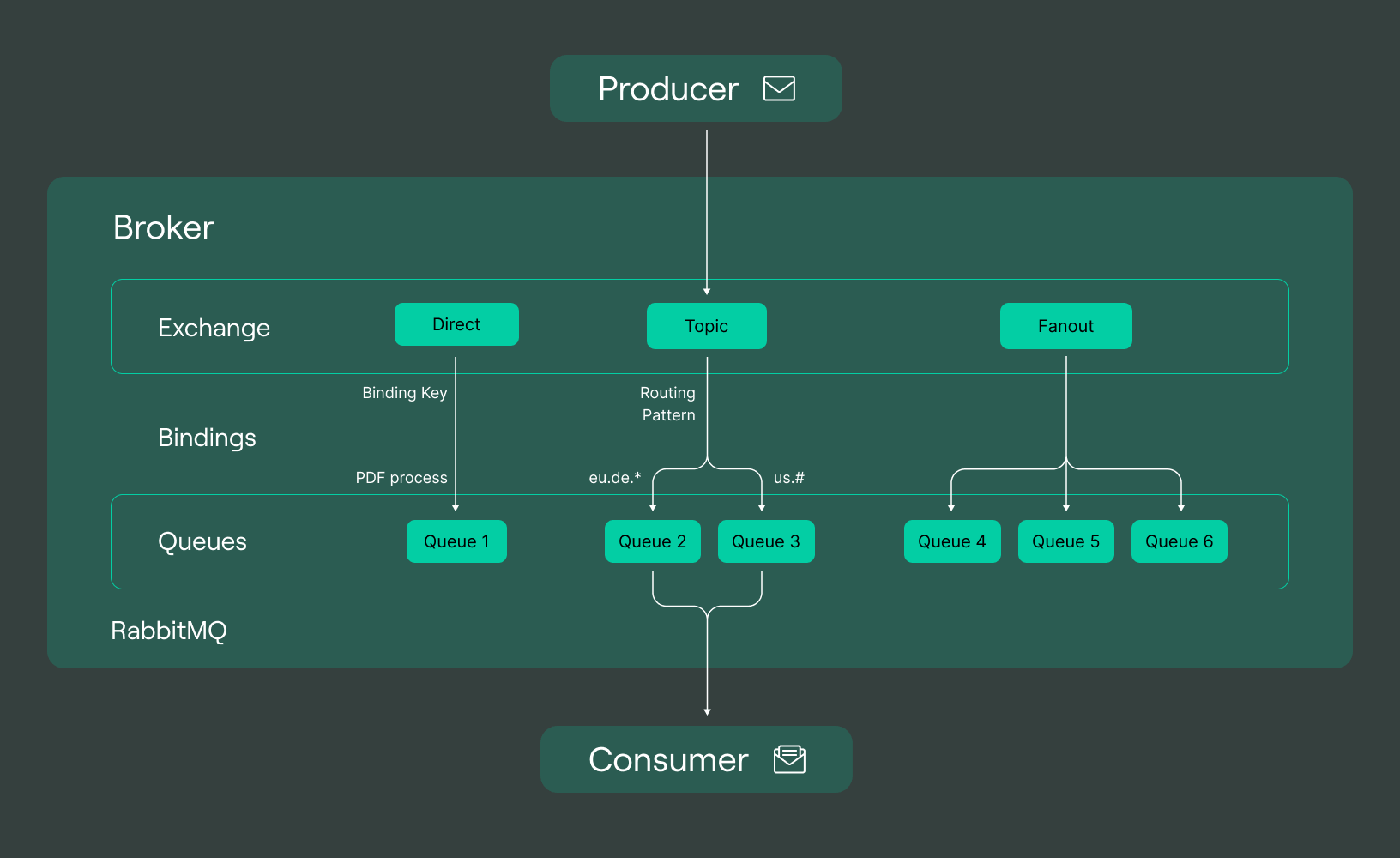
Exploring Kafka vs. RabbitMQ: Features, performance, and use cases
Apache Kafka and RabbitMQ are two popular open-source message handling pub/sub systems that connect consumer apps to producing apps or service platforms and pass information. Message brokers or message queue systems such as Kafka and RabbitMQ are highly beneficial for improving platform reliability, building new product features, or integrating multi services. In this article, we will compare and contrast these two advanced systems to discover which is the best fit for specific user needs.
What is Kafka?
As one of the most popular general purpose message brokers, Apache Kafka is an open-source system developed to enable high-ingress data streaming allowing applications to process and queue real-time data pipelines. Kafta is useful for event-driven and always-on large-scale applications enabling them to improve performance, scalability and flexibility.
Originally developed by LinkedIn in 2011, it has grown to be one of the most reliable systems for transmitting messages and analyzing data, website activity tracking, metrics collection and monitoring, logging, event stream sourcing and more.
Read more — What is Apache Kafka?
What is RabbitMQ?
Built for complex routing scenarios, RabbitMQ is one the most widely used message brokers that provide flexible routing capabilities within microservice architectures. It employs a push model to ensure low-latency messaging, using its priority queue architecture to access, store, and transmit data messages to consumers.
RabbitMQ supports integrations with JavaScript, Elixir, Go, Python, Java, NET, PHP, Ruby, Spring, Objective-C, Swift, and various other dev tools and plug-ins. Its system is ideal for high-throughput user cases and it adopts the message delivery acknowledgment method to process messages on both ends of the data transmission pipeline.
Apache Kafka vs. RabbitMQ: Full comparison on 17 aspects
In comparing Apache Kafka vs RabbitMQ, we shall delve into some of the important features and use cases that distinguish these two popular message brokers. This comparison between Kafka and RabbitMQ is aimed at providing big data engineers with the information they need to choose the right advanced message queuing protocol when making applications that need to interact with each other.
Requirements
The minimal system requirements for Apache Kafka to function as a durable message broker depend on a variety of variables, including the amount of your data, the volume of messages you need to handle, the number of topics, and the quantity of consumers and producers you anticipate having.
Nonetheless, Kafka can typically function on hardware that isn’t very powerful. The minimal system requirements to run it are:
-
At least 2 CPU cores
-
8GB of RAM
-
100GB of disk space
Remember that these are the minimums and that, depending on your specific use case, you could require additional resources. It is advised to set aside extra resources if you are using Kafka in a production setting or working with a lot of batch data to ensure best performance and dependability.
RabbitMQ has less stringent minimum system requirements. The minimal computer specifications for RabbitMQ are as follows:
-
At least 1 CPU core
-
512MB of RAM
-
1GB of disk space
Because of its reputation for being portable and simple to use, RabbitMQ is frequently chosen for small to medium-sized applications. Similar to Kafka, the precise resource needs vary depending on the use case, volume of data handled, and quantity of connections, producers, and consumers.
Use cases
Apache Kafka use case
Building real-time data pipelines for machine learning (ML) and artificial intelligence (AI) applications is one of Apache Kafka’s special use cases. Data processing and analysis are made possible by Kafka’s capacity to handle background jobs and enormous amounts of messaging data in real-time, which is crucial for ML and AI applications. Faster model training and real-time predictions are made possible by using Kafka as a central hub for ingesting, processing, and sending data to machine learning models and applications.
Building strong data pipelines for ML and AI applications requires a dependable and secure solution. Kafka’s fault-tolerance and data preservation ensure that data is not lost.
RabbitMQ use case
As a message broker for IoT (Internet of Things) devices, RabbitMQ has a variety of uses. Because of its portability and flexibility, RabbitMQ is the perfect solution for managing big data transfer and communication between a sizable number of IoT devices and sensors.
RabbitMQ enables efficient and dependable data sharing by handling high message throughput and distributing messages to the right hardware or software. RabbitMQ is a popular option for developing IoT applications and systems because it supports a number of protocols, including MQTT and AMQP, which makes it simple to interact with different IoT platforms and devices.
Architecture
The various architectural designs for different scenarios distinguish RabbitMQ from Apache Kafka. Messages are gathered in a queue and sent to one or more consumers in the conventional message queue architecture that RabbitMQ employs. RabbitMQ is extremely adaptable and configurable because it supports a broad variety of messaging patterns, including point-to-point, publish-subscribe, and request-reply.
On the other hand, Apache Kafka architecture is a distributed publish-subscribe model, in which data is written to topics and delivered in real-time to one or more consumers. Kafka’s architecture enables high throughput and low latency data processing, making it suitable for scale-out real-time data streaming.

Performance
Latency: RabbitMQ is faster than Apache Kafka in terms of latency. Because of its rapid message processing, RabbitMQ is a strong option for use cases like real-time processing where low latency messaging is crucial.
Throughput: Compared to RabbitMQ, Kafka has better throughput. It is built for high scalability and can be used to balance load processing while handling massive amounts of data. This makes it a viable option for use cases like stream processing and data pipelines where fast throughput is crucial.
Persistence: Regarding message persistence, Kafka saves messages in a durable log whereas RabbitMQ allows a range of choices. For scenarios where data loss cannot be allowed, Kafka’s log-based architecture makes it very robust and fault-tolerant.
Concurrency: Kafka offers superior support for the simultaneous processing of big data streams, whereas RabbitMQ is more effective at managing numerous concurrent connections.
Therefore, Kafka is better suited for use cases requiring high throughput and simultaneous processing of streams, whereas RabbitMQ is better suited for use cases requiring low latency and handling numerous concurrent connections.
Topology
Kafka employs a publish-subscribe format and is intended to be highly scalable and fault-tolerant in a distributed environment, whereas RabbitMQ uses a queuing approach and is suitable for moderate to high loads on a single server.
A central server processes and distributes messages to multiple consumers in the RabbitMQ centralized messaging system. The distributed messaging system Kafka, on the other hand, distributes messages among various brokers in a cluster.
Language
Both RabbitMQ and Apache Kafka support a variety of programming languages, however their client libraries and language support vary.
Many languages, including Java, Python, Ruby,.NET, and many more, are supported on RabbitMQ. It is simple to utilize RabbitMQ with a range of applications since it offers a big number of client libraries for these languages.
Java, Python, Ruby,.NET, and more languages are among those that Apache Kafka supports. In contrast to RabbitMQ, Kafka has fewer client libraries available, and some of those that are accessible are not as advanced.
However, both messaging systems are simpler to use across a variety of computer languages because of their robust documentation and active communities.
Scalability and redundancy
RabbitMQ and Apache Kafka have various approaches to scalability and redundancy. In fact, scalable and fault-tolerant messaging are features you can find on RabbitMQ. By adding extra resources to the server, it may be expanded vertically. Moreover, it enables clustering for high availability and load balancing. As data replication and failover are supported natively by RabbitMQ, it is a dependable option for mission-critical applications.
Kafka is intended to be a highly scalable and fault-tolerant distributed messaging system. It can be grown horizontally by adding more brokers to the cluster and is made to handle enormous volumes of data. Kafka’s distributed log-based design enables fault tolerance and long-term data storage. Because of its redundancy and fault tolerance provided by its replication and partitioning features, Kafka is a dependable option for large-scale data processing applications.
In essence, Kafka offers scalability and redundancy through its distributed design and replication features, whereas RabbitMQ does so through clustering and failover techniques. Although both systems are dependable and capable of running mission-critical applications, their unique architectures make them more appropriate for certain use cases.
Messaging
Message ordering
Apache Kafka preserves message ordering in partitions. Consumers within a consumer group read messages from the partition in the order they were written, and messages are written to a partition in the correct order. Therefore, there is no assurance of message ordering between different partitions. If a subject has several partitions, messages may be written to various partitions; as a result, if consumers view it from various partitions, messages may be received out of chronological order. The producer can employ a partition key to ensure that all relevant messages are written to the same partition in order to guarantee ordering across partitions.
By having a single consumer per queue, RabbitMQ, on the other hand, offers ordered message delivery. The sequence in which the consumer receives the messages determines how they are handled. Ordering is not ensured if multiple consumers are consuming from the same queue since the messages are divided among them in a round-robin method.
Message lifetime
An adjustable message retention period depending on time or size is what you get on Apache Kafka. As a result, messages will be kept in the Kafka cluster either until you collect log files up to a specified size or for a certain amount of time. The Kafka cluster will discard messages that have reached the end of their retention term, making them unavailable for message retrieval or dispersed data consumption.
The time-to-live (TTL) value of a message in RabbitMQ determines how long it will remain in the system. The producer sets the TTL, which determines how long RabbitMQ should keep a message before discarding it. RabbitMQ will reject a message and make it unavailable to consumers if the TTL value expires prior to message consumption.
Delivery guarantees
The “at least once delivery guarantee” offered by Kafka ensures that messages will reach recipients at least once, but perhaps more than once in the event of errors or reprocessing. To guarantee that messages are not lost in the case of a failure, Kafka uses a mix of message offsets and consumer group coordination. Users may additionally modify the delivery semantics in Kafka to offer more robust assurances, including exactly-once delivery.
On the other hand, depending on the message acknowledgement mechanism, RabbitMQ offers a number of delivery assurances. “Fire and forget” is the default delivery option in RabbitMQ, where a message is sent to a queue and promptly acknowledged by RabbitMQ without requesting a response from the consumer.
Message priorities
Apache Kafka is a distributed streaming technology made to manage large amounts of stream history and real-time data. The messages are handled in the order they are received since Kafka’s message model does not by default allow message priority. Nevertheless, Kafka enables you to manage the order in which messages are read by using message timestamps.
Conversely, RabbitMQ system makes use of message queues with different priority levels to enable message priorities. As messages are published in RabbitMQ, they are given a priority level, and consumers get them in the order of their priority. As a result, users can handle high-priority communications before low-priority ones.
|
Messaging |
Kafka |
RabbitMQ |
|
Message ordering |
Partitioned message delivery |
Ordered message delivery |
|
Message lifetime |
Message lifetime until log reaches a specified size or amount of time |
Producer sets time-to-live (TTL) value |
|
Delivery Guarantees |
Delivery guarantee available |
Delivery acknowledged by RabbitMQ not consumers |
|
Message priorities |
Message are handled in the order of reception |
Uses message queues with different priority levels |
Sequential ordering
Comparing Kafka vs RabbitMQ, both systems offer sequential ordering of messages, however they do it in slightly different ways. Apache Kafka ensures that messages inside a partition are handled in the order they are received, but messages across partitions may not always be processed in the same order. Contrarily, RabbitMQ enables rigorous message ordering, which ensures that messages are delivered to consumers in the same order in which they were published.
One consumer per queue, which guarantees that messages are handled in the order they are received, is used to do this. Nevertheless, because tight ordering in RabbitMQ limits parallelism and might cause message backlogs if the consumer cannot keep up with the volume of incoming messages, it can have an adverse effect on performance and scalability. In contrast, Kafka’s distributed design allows it to handle enormous volumes of messages and provide parallel processing, while yet retaining sequential ordering inside partitions.


Data type
Both Kafka and RabbitMQ are messaging platforms used for distributed systems' asynchronous communication. They process data types differently, which is one of their main differences. Kafka supports a number of data types, including binary, JSON, and Avro, and is primarily designed to process and analyzing streaming data, such as logs and metrics. processing a high number of gigabyte-sized messages is also a feature of Kafka.
RabbitMQ, on the other hand, supports a number of messaging protocols, including AMQP, STOMP, and MQTT, and is made to handle conventional message-oriented data, such as XML and JSON. Moreover, RabbitMQ offers more sophisticated functionality for effective message delivery and routing key features, including transactions and message acknowledgements. The decision between Kafka vs RabbitMQ ultimately comes down to the particular needs of the application and the kind of data being handled.
Pull vs push
Both the messaging technologies Kafka and RabbitMQ enable communication between dispersed systems. RabbitMQ is largely a push-based system where producers send messages to queues and receivers on the other end consume messages. In contrast, Kafka is essentially a pull-based system in which users retrieve pull messages from a partitioned log.
Due to this, RabbitMQ is more suited to use cases where message delivery assurances are crucial, such as in financial services or healthcare applications, whereas Kafka is excellent for use cases where consumers want fast throughput and low latency messaging. In the end, the use case’s particular needs will determine whether Kafka or RabbitMQ should be used.
Features
Both have publish-subscribe messaging and support for a variety of programming languages, but they differ in a number of important ways. Kafka includes a persistent, fault-tolerant storage system for message retention and is intended for high-throughput, low-latency streaming data applications, whereas RabbitMQ is targeted for high message throughput and has more adaptable messaging patterns.
RabbitMQ is simpler to set up and use than Kafka, which has a more complicated design and takes more resources to run. The choice of system to use when comparing Kafka vs RabbitMQ comes down to the particular requirements of your use case.
Protocol
The RabbitMQ and Kafka protocols each use a different approach, but Kafka employs a publish-subscribe model in which message publishers are topics, and message consumers are subscribers to those topics. Even after being consumed, messages are kept in a log and made available for a customizable amount of time. The message queueing methodology used by RabbitMQ can be used to send messages to a queue where they are then consumed in a first-in, first-out (FIFO) manner.
Several messaging protocols are supported by RabbitMQ, which also enables more intricate message routing and filtering. Overall, RabbitMQ’s message queueing style is better suited for more conventional messaging applications whereas Kafka’s publish-subscribe model is appropriate for high-throughput, real-time data streaming.
Monitoring
Both systems offer a variety of tools for monitoring their operation and general health. However, their strategies differ. A built-in metrics reporting system is offered on Kafka and may be accessible using JMX or combined with external monitoring tools. ‘Kafka-topics.
sh, ’ a command-line utility included with Kafka, may display details about topics and partitions. The web-based administration dashboard offered by RabbitMQ, on the other hand, enables users to keep an eye on secure client connections, exchanges, and queues in real-time. Moreover, plugins for RabbitMQ enable integration with other distributed monitoring service and tools. Generally, RabbitMQ’s management dashboard offers a more thorough picture of the system’s status and activity whereas Kafka’s monitoring tools are more concentrated on metrics and performance monitoring.
Routing
Compared to Apache Kafka, RabbitMQ offers more flexible routing possibilities. This is so that messages may be sent to specific or multiple queues or exchanges depending on message content or metadata. RabbitMQ supports a variety of message routing patterns, including direct, topic-based, and header-based routing.
Re-queuing and message acknowledgment are also supported by RabbitMQ, which is helpful for assuring dependable message delivery. As opposed to this, Kafka’s routing is based on topics, and messages are posted to certain topics that users may subscribe to. For high-throughput, real-time data streaming applications, Kafka’s method is easier and more effective, although it could not be as flexible as RabbitMQ in complicated routing scenarios.
Community and support
Although the open-source communities for Apache Kafka and RabbitMQ are both available and active, there are notable distinctions in their ecosystem and support. The Apache Software Foundation, which has a sizable contributor community and substantial corporate backing from organizations like Confluent and AWS, is the organization responsible for developing Kafka. To integrate Kafka with other systems, the Kafka community offers extensive documentation, tutorials, a variety of tools, and connectors. The community that supports RabbitMQ, on the other hand, is active and contributes plugins, integrations, and extensions to the main messaging system.
RabbitMQ was created by Pivotal Software. Moreover, RabbitMQ offers superb documentation and training, as well as commercial assistance from organizations like VMware. Generally, RabbitMQ and Kafka both have strong communities and commercial backing, but RabbitMQ offers a more narrowly focused and extendable core messaging technology, whereas Kafka has a larger ecosystem of tools and connections.
APIs and client libraries
The API and JMS client library designs of Kafka and RabbitMQ differ from one another. The producer and consumer APIs are the two main components of Kafka’s API, which is intended to be straightforward and basic. Moreover, Kafka offers a large range of client library implementation in several programming languages that are idiomatic and simple to use.
RabbitMQ’s API, in comparison, is more feature-rich and abstract and places more emphasis on message routing and exchange patterns. Furthermore accessible in a variety of programming languages, RabbitMQ’s client libraries offer a more complete and adaptable set of functionality for messaging patterns including RPC, fanout, and topic-based routing.
Security
To safeguard message data both in transit and at rest, Apache Kafka and RabbitMQ both include security capabilities. Although RabbitMQ enables both SSL and Transport Layer Security (TLS) encryption, Kafka supports SSL or TLS encryption. As further security measures to prevent unauthorized access to sensitive information, both additionally support SASL, Kerberos, and OAut for RabbitMQ, while Kafka supports SASL and Kerberos.
RabbitMQ supports plugins for advanced security measures including restricting the pace of messages or detecting and blocking malicious traffic, whereas Kafka adds extra security capabilities like access control lists (ACLs) for finer-grained authorization. Moreover, unlike RabbitMQ which lacks built-in support for message encryption, Kafka provides message encryption for data at rest using encryption keys controlled by external systems like Key Management Services (KMS).
Apache Kafka vs RabbitMQ: Comparison table
|
Comparison |
Apache Kafka |
RabbitMQ |
|
Use Cases |
Building real-time ML data pipelines |
Managing big data transfer and communication |
|
Architecture |
Publish-subscribe architecture |
Point-to-point, publish-subscribe, and request-reply architecture |
|
Performance |
Suited for high throughput data projects |
Suited for low latency data projects |
|
Topology |
Publish-subscribe format |
Queuing approach |
|
Language |
Java, Python, Ruby,.NET, plus large number of client libraries |
Java, Python, Ruby,.NET, but fewer number of client libraries |
|
Scalability and Redundancy |
Distributed design and replication scalability and redundancy features |
Clustering and failover scalability and redundancy techniques |
|
Messaging |
Unbounded data flow |
Distinct, bounded data flow |
|
Sequential Ordering |
Partitioned messages are handled in the order received |
Messages are received in the published order |
|
Data Type |
Supports binary, JSON, and Avro |
Supports AMQP, STOMP, and MQTT |
|
Pull vs Push |
Pull-based system |
Push-based system |
|
Features |
Persistent, fault-tolerant storage systems, low latency |
High message throughput with adaptable messaging patterns |
|
Protocol |
Publish-subscribe model |
Message queueing methodology |
|
Monitoring |
Built-in metrics reporting system |
Web-based administration dashboard |
|
Routing |
Topic based routing |
Direct, topic-based, and header-based routing pattern |
|
Community and support |
Documentation, tutorials, a variety of tools, and connectors available |
Plugins, integrations, extensions, documentation, training, and commercial assistance available |
|
APIs and client libraries |
Producer and consumer API |
Feature-rich and abstract API with message routing and exchange patterns |
|
Security |
SSL and Transport Layer Security (TLS) encryption |
SSL or TLS encryption |
Pros and cons of Apache Kafka
Pros
-
Kafka is scalable and can handle a large number of messages in real-time.
-
It is fault-tolerant and ensures that messages are always available, even in the event of a hardware failure.
-
Kafka provides flexible and configurable options, with a large ecosystem of connectors for integration with other systems.
-
It is an open-source software, making it free to use and highly customizable.
Cons
-
Kafka can be complex to set up and maintain, especially for smaller projects.
-
Running Kafka can be expensive as it requires a significant amount of resources.
-
Kafka has a maximum message size limit and maintaining message ordering can be challenging in certain scenarios.
-
Kafka lacks built-in security features, and there is a small possibility of data loss in certain cases. It may not be suitable for smaller projects with low message volume.
Pros and cons of RabbitMQ
Pros
-
RabbitMQ is a highly scalable messaging system that is capable of handling large volumes of stored messages and distributing them across multiple nodes.
-
It is a reliable messaging system that uses acknowledgments to ensure that messages are not lost in transit and provides advanced features such as message routing, dead letter queues, and message prioritization.
-
RabbitMQ is user-friendly, supports multiple messaging protocols and programming languages, and can be easily configured and deployed using various tools and platforms.
-
RabbitMQ is suitable for both small and large projects, and it is an open-source software that is free to use and highly customizable.
Cons
-
RabbitMQ’s scalability is limited by the resources of its host machine, and it may not perform well in highly distributed environments or under heavy load.
-
Like Kafka, RabbitMQ can be complex to set up and maintain, especially for smaller projects.
-
RabbitMQ has a maximum message size limit, may not be as durable as other messaging systems, and requires Erlang knowledge to use.
-
RabbitMQ may introduce latency and require more resources to operate efficiently, making it less suitable if you’re looking to process data in real-time.
How can DoubleCloud help you with Apache Kafka?
DoubleCloud is a cloud-based platform that offers a range of services to help organizations manage their Apache Kafka deployments more effectively. With managed Kafka on DoubleCloud, users can easily provision Kafka clusters and manage them from a centralized dashboard, reducing the complexity and overhead of managing Kafka deployments manually. DoubleCloud also provides real-time monitoring and alerting, allowing users to quickly identify and respond to any issues that may arise.
Additionally, the platform offers a range of security features, including encryption and access control, to ensure the integrity and confidentiality of Kafka data. Overall, DoubleCloud simplifies the management of Kafka deployments, making it easier for organizations to take advantage of Kafka’s powerful capabilities.
Final words
Choosing between Kafka and RabbitMQ can be a challenging decision, as both messaging systems have their strengths and weaknesses. Ultimately, the decision will depend on your specific use case and requirements. Consider the pros and cons of each system carefully as listed above, and evaluate which one aligns best with your needs.
Frequently asked questions (FAQ)
When should you use Apache Kafka vs RabbitMQ?
When should you use Apache Kafka vs RabbitMQ?
Kafka is ideal for high-throughput, real-time processing, and handling large volumes of data. It is suitable for real-time data streaming, event-driven architectures, and distributed data processing. RabbitMQ may be a better fit for scenarios that require more reliability and flexibility in messaging protocols and languages.
Is RabbitMQ faster than Kafka?
Is RabbitMQ faster than Kafka?
Is Kafka higher performance than RabbitMQ?
Is Kafka higher performance than RabbitMQ?
Is it easier to manage Kafka than RabbitMQ?
Is it easier to manage Kafka than RabbitMQ?
Start your trial today



